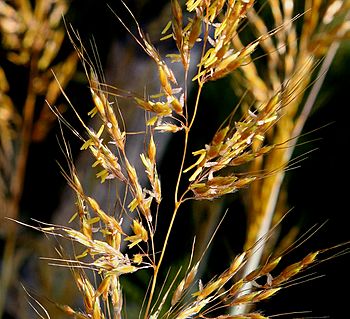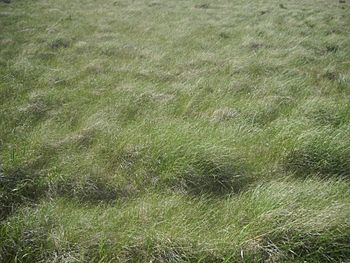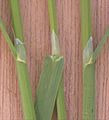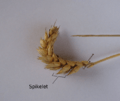True grasses facts for kids
Quick facts for kids Poaceae (true grasses) |
|
|---|---|
 |
|
| Flowering head of Meadow Foxtail (Alopecurus pratensis), with stamens exserted at anthesis | |
| Scientific classification | |
| Kingdom: | |
| Division: | |
| Class: | |
| Order: | |
| Family: |
Poaceae
|
Poaceae, also known as Gramineae, are the "true" grasses. They belong to a very large group of flowering plants called monocots. There are about 10,000 different types (species) and 660 groups (genera) of grasses! They are one of the most important plant families for both nature and people.
Plants like rushes and sedges look similar to grasses, but they are not part of the Poaceae family. However, they are related.
Grasslands cover about 20% of the Earth's land. Grasses also grow in many other places. You can find them in wetlands (swamps), forests, and even cold tundra regions.
Many important cereal crops that people eat every day are grasses. These include maize (corn), wheat, millets, and rice. Grasses are super important for our economy. They provide food for animals (forage), building materials like bamboo and thatch for roofs, and even fuel like ethanol.
How Grasses Grow
Grass blades grow from their base, not from the tips of their stems. This special way of growing helps grasses survive. When animals graze on them or when they are mown, the low growth point means the plant isn't badly damaged. It can quickly grow back!
Grasses grow in a few different ways:
- Bunch-type: These grasses grow in clumps or bunches.
- Stoloniferous: These spread using stolons, which are stems that grow along the ground.
- Rhizomatous: These spread using rhizomes, which are stems that grow underground.
Grasses are very successful because of how they grow and their different ways of making food. Most grasses use one of two main ways to turn sunlight into energy (photosynthesis): C3 or C4 pathways.
C4 grasses are very good at saving water. This makes them perfect for hot, dry places. C3 grasses are often called "cool-season" grasses. C4 grasses are known as "warm-season" grasses.
Here are some examples:
- Annual cool-season grasses: These grow for one year in cooler weather. Examples are wheat, rye, and oat.
- Perennial cool-season grasses: These grow back year after year in cooler weather. Examples include fescue (Festuca species) and Kentucky bluegrass.
- Annual warm-season grasses: These grow for one year in warmer weather. Examples are maize and pearl millet.
- Perennial warm-season grasses: These grow back year after year in warmer weather. Examples include big bluestem and switchgrass.
Where Grasses Live
The grass family is one of the most common plant groups on Earth. You can find grasses on every continent, even Antarctica! The Antarctic hair grass grows on the Antarctic Peninsula.
Grasses in Nature

Grasses are the main plants in many places. These include grasslands, salt marshes, and steppes. They also grow as a smaller part of the plants in almost every other land habitat.
Large areas mainly covered by grasses are called grasslands. These grasslands cover about 31% of the planet's land! Famous grasslands include pampas, steppes, and prairies.
Grasses are a very important food source for many animals. This includes large grazing mammals like cows, deer, and elephants. Many butterflies and moths also eat grass.
Animals that mainly eat grass are called graminivores. These include cattle, sheep, horses, rabbits, and many small creatures like grasshoppers. Even some omnivores (animals that eat both plants and meat) or carnivores (meat-eaters) might eat grass sometimes.
Grasses are special because their growth point is near the bottom of the plant. This means they can quickly recover after being eaten or cut.
The growth of large grazing animals millions of years ago helped grasses spread. These animals would eat young trees, but not grasses. This allowed grasses to become the main plants in many areas.
Images for kids
-
The gray area is the cricket pitch currently in use. Parallel to it are other pitches in various states of preparation which could be used in other matches.
-
Grass-covered house in Iceland
-
A Chasmanthium latifolium spikelet
-
Barley mature spikes (Hordeum vulgare)
-
Illustration depicting both staminate and pistillate flowers of maize (Zea mays)
See also
 In Spanish: Gramíneas para niños
In Spanish: Gramíneas para niños
























